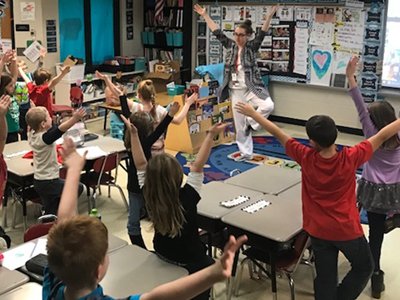Classroom Physical Activity Breaks
Physical activity doesn't have to be in a recess or PE setting to be effective.
Read More Study after study shows that kids who get regular physical activity experience improvements not just in their fitness levels but in brain function, too. Beginning the day with a walk or bike to school or moving before starting schoolwork at home can prime the brain for learning. It makes sense – kids need to move more. When they do, they are better positioned to succeed in the classroom and at home.
Study after study shows that kids who get regular physical activity experience improvements not just in their fitness levels but in brain function, too. Beginning the day with a walk or bike to school or moving before starting schoolwork at home can prime the brain for learning. It makes sense – kids need to move more. When they do, they are better positioned to succeed in the classroom and at home.
Creating active learning opportunities can be as simple or grand as you make them. Whether in the classroom or while studying or spending time as a family at home, active learning is just as important. Try these activities for different subjects or come up with your own.
All children need regular physical activity! It is particularly important for children with special needs to be included in activities that improve physical fitness. Variations and modifications of movements and activities should be offered to children to create a learning environment that is welcoming and respectful of all abilities. Adapted physical activities will ensure that children learn and achieve success at their own pace regardless of physical limitations or fitness level.
Build support and coordination of daily, school-wide physical activity opportunities by providing professional development and resources to help teachers get started in the classroom. Make it the new norm together! Share this information with families, or if a parent or caregiver, share how you create active learning opportunities at home or volunteer in the classroom.
Consider cross-curricular teaching and learning with your physical education teacher by aligning content themes and collaborating on lesson plans and projects. Ask the PE teacher to suggest a few safe, age-appropriate activities that connect to skills taught in physical education class.
Develop a plan with your school health team and seek feedback from the principal and teachers. Share simple ideas and lesson plans to introduce physical activity into the school day.
Participate in physical activities with your kids. Kids will be more likely to participate if they see you embracing the activity.
Partner with school health team members or parent/caregiver volunteers to gather resources on adding movement to the classroom
For more activities and ideas like this one, be sure to sign up for our news and updates. And if you like what you see, please donate to support our work creating more ways to help build a healthier future for kids.
Categories: Physical Activity & Play, Social-Emotional Health, At Home, At School, Digital Resource